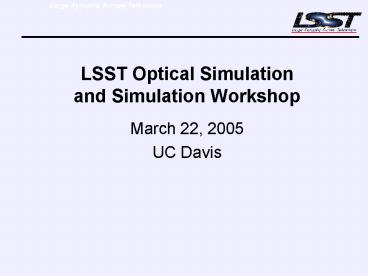LSST Optical Simulation and Simulation Workshop PowerPoint PPT Presentation
1 / 20
Title: LSST Optical Simulation and Simulation Workshop
1
LSST Optical Simulationand Simulation Workshop
- March 22, 2005
- UC Davis
2
(No Transcript)
3
Overview Optical Simulation status
Image sources/cosmology
- Statistical galaxies high state of readiness.
- N-body galaxies proposed activity just starting
(w/ UC San Diego) - Images medium state of readiness some HST,
proposed SuperMACHO
Atmosphere models
- Ab initio Kolmogorov etc. coded, in first
validation stages - Arroyo (a TMT software product) advanced state
of readiness
Optical Telescope model
- High state of readiness
Camera Optical model
- Medium state of readiness, but includes software
hooks
Optical System integration
Components operational, integration just starting
Acquiring validation data
- Medium state of readiness SOAR in April, ongoing
analysis of atmospheric data
4
Present project contributors
Chuck Claver/NOAO PSF 2nd moments with
Skylight code Test exposures on SOAR Vera
Margonier/UCDavis 10-second Subaru fields data
analysis David Wittman/UCDavis Statistical
galaxy/star fields, cosmology Michael
Norman/UCSD N-body galaxies, cosmology Steve
Asztalos/LLNL High-fidelity atmosphere with
Arroyo code Garrett Jernigan/KIPAC-SLAC
SSL-UCB and John Peterson/KIPAC-SLAC Ray
tracing Ab initio atmosphere Sensor model
(includes work by A.Rasmussen) Leslie
Rosenberg/LLNL integration, atmosphere data
Talking today
5
Software Components Pre-lensing Images
- currently using IRAF's artdata package for
size/shape/magnitude - homebrew software for redshift/color
- artdata again to make the image
6
Atmosphere models
- Atmospheric modeling software was surveyed. One
author (Matthew Britton Arroyo) had done his
own survey.
7
Arroyo selected
Results Arroyo selected on these bases
Modifiable Documented Extensible to large
FOVs Supported Free Parallelized
Arroyo installed on LLNL machines
8
Justification for Quantum Monte Carlo Approach
for Large Field Simulations for LSST
- Example 800"x800" R band image (1 CCD for
10s) - - 3x1010 background photons
- - few 104 Stars gt12 mag ( 108
photons) - (few tens of stars
per sq. arc min.) - - 106 Galaxies ( 108 photons)
- (1 galaxy
per sq. arc sec) - (Common Approach in High Energy
Astronomy) - Galaxies and Stars must be simulated to deep
S/N levels - in stacks of hundreds of separate images.
- New PSF every 5" with an accurate atm. model
- Each photon from a faint galaxy requires a
private PSF - 20 us per photon for fast ray trace
through atm. - 10 ms per photon for full diffraction
through atm. - Simulation with 1 G5 2GHz PowerPC
- no background photons or bright stars
(lt12mag) - 1 hour for Stars and Galaxies (12 layer
atm.) - 8 hours for Stars and Galaxies (full
end-to-end)
SDSS Data
LSST Data
Stars
Galaxies
From Yasuda et al., 2001, ApJ, 122,1104 (figure9)
Key Point Why a quantum approach is necessary.
9
Single layer phase screen based on Kolmogorov
spectrum - Refraction Raytraced
Phase Map
Vector Perturbations
Key Point Invention of a large aperture
approximation
10
Angular Correlation Distribution of Vector
Ellipticity(single layer 10 km outer scale 50m)
Normal to Wind Direction
Vector Ellipticity Difference
Parallel to Wind Direction
Separation Angle (arc seconds)
Key Points PSF correct for weak lensing
Prediction of wind effect.
11
Atmosphere Interface and Raytrace
LSST Aperture
Vector Screen 2048 squared 0.1m/pixel can have
arbitrary number with arbitrary wind velocity
vectors at given altitude Photons raytraced and
shifted accordingly Include atmospheric
dispersion afterwards
Optics
12
Detector (Rasmussen)
Refraction for light entering the Si
surface Photon interaction (wavelength and
temperature dependent) Lateral diffusion due to
finite electric field Validation Process
ongoing to maintain consistency with
sensor group
13
Speed Budget
Optics 200us (600 us) Atmosphere 2
us per layer Sky/SED few us Detector
few us Overhead 10 us So better than 1 ms
per photon (probably can get to 0.1 ms) (1-3
minutes of initial overhead) 0 mag 2 10-9
ergs/cm2/s/A LSST is 380000 cm2 (unvignetted) R
band is 2000 A, and is 3 10-12 ergs 10 s
exposure 0 mag source gives 5 1012 photons 30 mag
source gives 5 photons
14
Speed Budget (Cont.)
Stars N/s.dg. Photons/s.dg.
Time/chip (hr) lt12 mag 20 1 1010
28 12-17 600 3 109
8 18-22 2500 1 108
0.5 23-27 9000 5 106
0 28-32 ?
? 0 Galaxies lt12 mag
0 0 0 12-17
5 3 107 0 18-22 2000 1
108 0.5 23-27 8 105 ? 4 108
1? 28-32 ? ?
? Sky Background equiv. to 20-22 mag per
arcsec2 gt 6 1011 / sq. deg., 70 days (One
chip is 1/20th of sq. degree) Bahcall Soneira
1981, Yasuda et al. 2001
15
Zoomed in UDF
16
(No Transcript)
17
IM in the Design Process
18
Computation kernels
Time domain simulations
Integrated model glueware between well
established engineering tools
19
Atmospheric Simulation Requirements
- Model long-exposure atmospheric MTF for
seeing-limited instruments - Tilt-included or tilt-removed
- Standard methods appear adequate for visible
spectrometers - Model turbulence realizations for active- and
adaptive optics simulations
20
Cerro Pachon Atmosphere Experiment
- Cerro Pachon Facilities
- SOAR 4.2m Telescope
- Gemini 8m Telescope
- MASS
- DIMM
- Weather
- All-sky Camera
DIMM Integrated Measurement
MASS Structure above 500m

